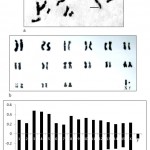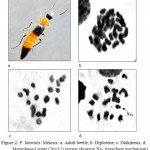Manuscript accepted on : 24 June 2018
Published online on: 29-06-2018
Plagiarism Check: Yes
Arshad Ayoub Bhatti and Manvi Khajuria
and Manvi Khajuria
Department of Zoology, University of Jammu, Jammu and Kashmir-180006, India.
Corresponding Author E-mail: arshadayoub60@gmail.com
DOI : http://dx.doi.org/10.13005/bbra/2654
ABSTRACT: In the present study, the chromosomes of a predatory rove beetle Paederus littoralis were studied from Jammu region of outer Himalayas. These beetles are also potential bio-control agents in suppressing the populations of cereal aphids. The diploid chromosome number was found to be 2n=32 including 22 metacentric, 3 submetacentric, 6 subtelocentric and 1 telocentric chromosomes. The sex chromosomes (Xyp) included submetacentric X and telocentric y chromosome. Meiotic observations comprised diplotene, diakinesis and metaphase-I. The study is helpful in solving taxonomic problems with in the family Staphylinidae and it authenticates the existence of this particular species through chromosomal data.
KEYWORDS: Chromosomes; Diplotene; Metacentric; Paederus
Download this article as:| Copy the following to cite this article: Bhatti A. A, Khajuria M. Karyotypic and Morphometric Analysis of A Predatory Rove Beetle, Paederus littoralis (Coleoptera: Staphylinidae) from Jammu Region of Outer Himalayas, India. Biosci Biotech Res Asia 2018;15(2). |
| Copy the following to cite this URL: Bhatti A. A, Khajuria M. Karyotypic and Morphometric Analysis of A Predatory Rove Beetle, Paederus littoralis (Coleoptera: Staphylinidae) from Jammu Region of Outer Himalayas, India. Biosci Biotech Res Asia 2018;15(2). Available from: https://www.biotech-asia.org/?p=30336 |
Introduction
Beetles of family Staphylinidae are commonly known as rove beetles. It is one of the richest families of Coleoptera with species that are mostly predacious. More than 45000 species of Staphylinid beetles are known worldwide and possibly over 75% of tropical species are still not described.1 These beetles have efficient role in biological control of cereal aphids.2 The earliest karyological investigations on the beetles of family Staphylinidae were carried out by Stevens.3,4 As lot of cytogenetic research work has been done on other families, little attention was paid on the chromosomal studies of family Staphylinidae and approximately 57 species are cytogenetically known today.5,6,7,8,9,10 During present investigation chromosomal analysis was done to study karyomorphometrical and meiotic details of this beetle.
Material and methods
Adult specimens of Paederus littoralis were collected from the agricultural fields of Talab Tillo area of Jammu region during April-May 2016. They were found in the soil due to their predatory habit, feeding on insects and other soft bodied invertebrates. Adult male beetles were used for present chromosomal studies. Slides were prepared by staining method described by Rozek11 with some modifications.
Beetles were anesthetized and dissected on a clean glass slide to obtain their testes which are found in the last segments of the abdomen. Testis tissue was treated with 0.7% KCl for 10-15 minutes. After hypotonic treatment, few drops of freshly prepared Cornoys fixative (3:1 absolute methanol and glacial acetic acid) were poured on the tissue. Then the tissue was stained with a drop of 1% aceto-orcein stain. After few seconds the tissue was covered with a clean coverslip and then squashed by vertical pressure applied gently by the thumb. The temporary mounts were sealed with wax and later made permanent. Stained slides were scanned under Olympus camera aided microscope and results were photographed under CH20i BIMF microscope attached with Sony SSC-DC378P camera under 1000X magnification.
Results
Spermatogonial metaphase showed diploid chromosome number 2n=32 (fig. 1a). The karyotype prepared from the spermatogonial metaphase complement revealed 22 metacentric chromosomes, 3 submetacentric chromosomes, 6 subtelocentric chromosomes and 1 telocentric chromosome (fig. 1b). The diploid chromosomal formula was found to be 22m+3sm+6st+1t. The sex chromosomes included submetacentric X and telocentric y chromosome. Idiogram of chromosomes (fig. 1c) represented the diagrammatic summary of the karyotype to make the individual chromosomal clearer.
 |
Figurer 1: Paederus littoralis (Gravenhorst). a. Spermatogonial metaphase (bar=5μm), b. Karyotype (22m+2sm+6st+Xy), c. Idiogram.
|
The karyomorphometrical analysis (table 1) of the spermatogonial metaphase complement showed the absolute length of autosomes to vary from 1.19μm to 0.50μm while the X and Y chromosome measured 0.65μm and 0.10μm respectively. All the chromosomes showed a gradual decrease in size. Meiotic observations included the stages diplotene, diakinesis and metaphase-I (fig. 2). There were present fifteen autosomal bivalents in the form of thick condensed rods in diplotene stage (fig. 2b). Diakinesis is represented by fifteen ring shaped autosomal bivalents with almost terminalized chiasmata (fig. 2c). Sex pair was also visible in the form of a parachute. Metaphase-I showed highly condensed autosomal bivalents and a sex bivalent showing parachute configuration formed by a large X and a small dot like y chromosome (fig. 2d). The sex chromosomes showed specific parachute type morphology, the characteristic feature of most Coleopteran species represented by Xyp (fig. 2d). The diploid chromosome number of this species was also confirmed through the diakinesis and metaphase-I stage (fig. 2c,d) in which 15 autosomal bivalents and a sex bivalent (Xyp) were recorded.
Table 1: Morphometric data of karyotype of male Paederus littoralis showing 2n=32 (22m+3Sm+6st+1t).
| Chromosome pair number | Mean length of the short arm (p) in µm | Mean length of the long arm (q) in µm | Absolute length of the chromosome (p+q) in µm | Arm ratio (q/p) | Centromeric index | Nomenclature |
| 1 | 0.29 | 0.90 | 1.19 | 3.10 | 24 | Subtelocentric |
| 2 | 0.22 | 0.85 | 1.07 | 3.86 | 21 | Subtelocentric |
| 3 | 0.48 | 0.56 | 1.04 | 1.16 | 46 | Metacentric |
| 4 | 0.46 | 0.52 | 0.98 | 1.13 | 47 | Metacentric |
| 5 | 0.43 | 0.52 | 0.95 | 1.21 | 45 | Metacentric |
| 6 | 0.22 | 0.60 | 0.92 | 2.72 | 27 | Submetacentric |
| 7 | 0.19 | 0.58 | 0.77 | 3.05 | 25 | Subtelocentric |
| 8 | 0.37 | 0.38 | 0.75 | 1.02 | 49 | Metacentric |
| 9 | 0.30 | 0.43 | 0.73 | 1.43 | 41 | Metacentric |
| 10 | 0.33 | 0.39 | 0.72 | 1.18 | 46 | Metacentric |
| 11 | 0.29 | 0.42 | 0.71 | 1.44 | 41 | Metacentric |
| 12 | 0.28 | 0.35 | 0.63 | 1.25 | 44 | Metacentric |
| 13 | 0.24 | 0.32 | 0.56 | 1.33 | 43 | Metacentric |
| 14 | 0.20 | 0.31 | 0.51 | 1.55 | 39 | Metacentric |
| 15 | 0.22 | 0.28 | 0.50 | 1.27 | 44 | Metacentric |
| X | 0.23 | 0.42 | 0.65 | 1.82 | 35 | Submetacentric |
| y | 0 | 0.10 | 0.10 | – | – | Telocentric |
| Total | 4.75 | 7.83 | 12.68 |
 |
Figure 2: P. littoralis. Meiosis: a. Adult beetle, b. Diplotene, c. Diakinesis, d. Metaphase-I stage (2n=32) (arrow showing Xyp parachute mechanism).
|
Discussion
Paederus littoralis presented a diploid chromosome number of 2n=30+Xyp in males. The diploid chromosome number in family Staphylinidae varies from 2n=18 to 2n=567. From the subfamily Paderinae, diploid chromosome number 2n=36 (n=17+Xyp) has been found in Paderius rubrathoracicus but the sex mechanism was same as shown in the present studied species.12 They also reported the presence of heteromorphic male sex pair in the form of a parachute during diplotene stage of meiosis-I. In genus Paederus the following chromosome numbers were recorded: n♂ =10+Xyp in one species, n♂=14+Xyp in one species, n♂=15+Xyp also in one species and n♂=16+Xyp I four species.6,13,14
Conclusion
Paederus littoralis showed diploid chromosome number 2n=32 in males. There were present 22 metacentric, 3 submetacentric, 6 subtelocentric and 1 telocentric chromosomes. Sex mechanism was found to be Xyp in which X is submetacentric and y as a rounded telocentric body. Meiosis represented by diplotene, diakinesis and metaphase-I stages.
Acknowledgements
Thanks are due to Prof. Seema Langer, HOD Zoology, University of Jammu for providing necessary lab facilities.
Conflict of Interest
We certify that we have no conflict of interest.
Funding source
There is no particular funding source.
References
- Howard J.F, Woodruff R, Beck B.M, Skelley P.E, Schotman C.Y.L, Thomas M.C. Checklist and bibliography of the insects of Grenada and the Grenadines. Center for Systematic Entomology. 1998;2.
- Kollat-Palenga I, Basedow T. Aphid feeding of predatory Staphylinidae on different strata (soil surface and wheat seedlings) in laboratory experiments. Journal of Plant Diseases and Protection. 2000;107:643-648.
- Stevens N.M. A comparative study of the heterochromosomes in certain species of Coleoptera, Hemiptera and Lepidoptera, with special reference to sex determination. Carnegie Institution of Washington. 1906;36:33-74.
- Stevens N.M. Further studies on the chromosomes of Coleoptera. Journal of Experimental Zoology. 1909;6: 101-121.
CrossRef - Smith S.G, Virkki N. List of chromosome numbers of Coleoptera, In: B John (ed.); Animal Cytogenetics, Insecta 5. Gebruder Borntraager, Berlin stuttgert. 1978;3:366.
- Yadav J.S, Burra M.R, Singh J. Chromosome number and meioformulae in 36 species of Indian Coleoptera (Insecta). National Academy Science Letters. 1987;10(6):223-227.
- Yadav J.S, Chand S, Yadav A.S. Comparative karyology of twenty species of Philonthus Curtis. Elytron (Barcelona). 1994;8(0):5-18.
- Vorontsov N.N, Yadav J.S, Lyapunova E.A, Korablev V.P, Yanina I.Y. Comparative karyology of seven species of staphylinoid beetles (Polyphaga: Coleoptera). Genetica. 1984;63:153-159.
CrossRef - Dange M.P, Panday B.L, Rathore A. Chromosomal investigations on four species of dung beetles (Insecta). Cibtech Journal of Zoology. 2013 a;2(1):11-14.
- Dange M.P, Panday B.L, Rathore A. Chromosomal studies on four species of Staphylinidae (Coleoptera: Insecta). Journal of Entomological Research. 2013 b;37(3):289-292.
- Rozek M. A new chromosome preparation technique for Coleoptera (Insecta). Chromosome Research. 1994; 2:76-78.
CrossRef - Lachowska D, Pasnik G. C-banding patterns in chromosomes of Paederius rubrothoracicus carpathicola Scheerpetz 1957 (Coleoptera, Staphylinidae: Paederinae). Folia biologica (Krakow). 2000;48:3-4.
- Yadav J.S, Chand S. Karyology of four species of Staphylinid beetles (Polyphaga: Coleoptera). Nuclues. 1986; 29:112-115.
- Yadav J.S, Chand S. Karyology of seven species of Paederinae (Stapylinidae: Coleoptera). Genet. Iber. 1989;41:119-133.

This work is licensed under a Creative Commons Attribution 4.0 International License.





